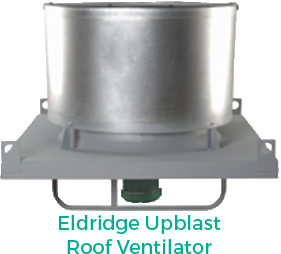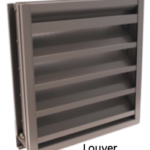Weld Shop Fume Extraction
The welding process can expose an employee to harmful heat, light and fumes. The largest of these risks is the base metal particles that may be contained in the welding fumes. If not properly ventilated, exposure to the weld fumes can cause brain, nervous system and lung damage. When a customer called Eldridge to design a ventilation system for their two new welding bays, we knew exactly what needed to be done to create a safe work environment for their welders.
Air Flow
Source extraction is the preferred ventilation method for weld fumes. However, because of the size of items to be welded, source extraction was not practical in this case. Therefore, to keep the dangerous fumes away from welders, we needed to provide sufficient air flow to move the fumes to a more remote extraction point. We determined that an air change rate of 13 times per hour in the localized area of the building around the welding bays would provide a sufficient volume of air to move the weld fumes.
 Extraction Point
Extraction Point
To keep exposure to the weld fumes to a minimum, the remote extraction point needed to be the nearest roof or wall location. With the weld bays in the center of the building, the roof directly above was the nearest extraction point. This also allowed us to take advantage of the natural tendency of the heated weld fumes to rise. We placed eight roof exhaust fans over the two welding bays to pull the weld fumes up and away from the welders.
Negative Pressure
When designing a ventilation system for fume extraction, it should result in a negative building pressure. The primary benefit of a negative pressure ventilation system is that it keeps the fumes from infiltrating places like adjacent offices. In this case, that was accomplished with a ventilation system design that had roof fans for powered exhaust and wall louvers for gravity supply. However, because of the high volume of exhaust air, we needed to size the wall louver area sufficiently larger enough to keep from over pressurizing the building and causing safety issues with man doors.
Louver Placement
 Air will choose the path of least resistance when flowing from a supply point to an exhaust point. With our exhaust fans located on the roof, we located the louvers at the floor level. This would create a flow of air at ambient temperature across the weld bays to keep the welders cool and move the weld fumes. We were also able to place the louvers on the sides of the buildings facing the prevailing winds so that our ventilation system worked with and not against nature.
Air will choose the path of least resistance when flowing from a supply point to an exhaust point. With our exhaust fans located on the roof, we located the louvers at the floor level. This would create a flow of air at ambient temperature across the weld bays to keep the welders cool and move the weld fumes. We were also able to place the louvers on the sides of the buildings facing the prevailing winds so that our ventilation system worked with and not against nature.
Conclusion
In the end, the ventilation system we designed for the customer to extract weld fumes incorporated the same type of equipment we have used for other general ventilation application. What made this weld shop fume extraction application unique was our expertise in knowing the required amount of air flow and the placement of the equipment to move the weld fumes in the desired direction away from the welders, thus, creating the safe work environment that the customer desired.

